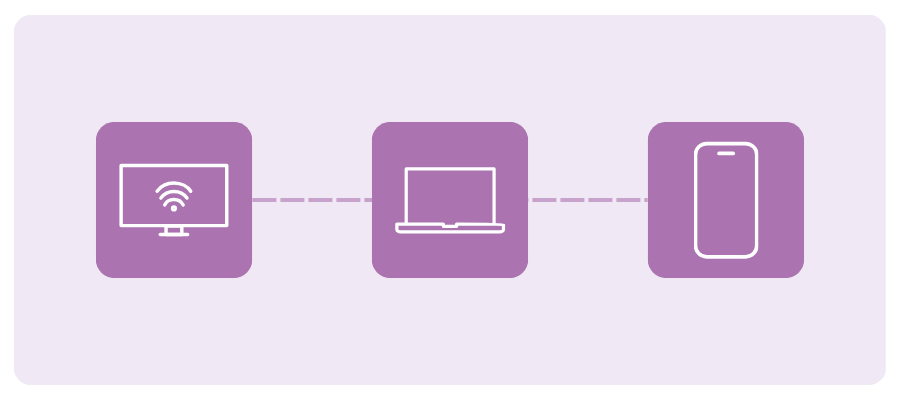At A Glance
Infillion and Experian collaborate to help advertisers connect with audiences across devices and channels, as cookies and mobile identifiers disappear. By integrating Experian's Digital Graph and Offline Identity Resolution, Infillion strengthens identity connections, improves campaign reach, and enhances audience engagement across CTV, mobile, and web.In our Ask the Expert Series, we interview leaders from our partner organizations who are helping lead their brands to new heights in AdTech. Today’s interview is with Ben Smith, VP of Product, Data Products at Infillion.
Adapting to signal loss
What does the Experian–Infillion integration mean for advertisers looking to reach audiences as signals fade?

As cookies and mobile identifiers disappear, brands need a new way to find and reach their audiences. The Experian integration strengthens Infillion’s XGraph, a cookieless, interoperable identity graph that supports all major ID frameworks, unifying people and households across devices with privacy compliance, by providing a stronger identity foundation with household- and person-level data. This allows us to connect the dots deterministically and compliantly across devices and channels, including connected TV (CTV). The result is better match rates on your first-party data, more scalable reach in cookieless environments, and more effective frequency management across every screen.
Connecting audiences across channels
How does Experian’s Digital Graph strengthen Infillion’s ability to deliver addressable media across channels like CTV and mobile?

Experian strengthens the household spine of XGraph, which means we can accurately connect CTV impressions to the people and devices in that home – then extend those connections to mobile and web. This lets us plan, activate, and measure campaigns at the right level: household for CTV, and person or device for mobile and web. The outcome is smarter reach, less waste from over-frequency, and campaigns that truly work together across channels.
The value of earned attention
Infillion has long championed “guaranteed attention” in advertising. How does that philosophy translate into measurable outcomes for brands?

Our engagement formats, such as TrueX, are based on a simple principle: attention should be earned, not forced. Viewers choose to engage with the ad and complete an action, which means every impression represents real, voluntary attention rather than passive exposure. Because of that, we consistently see stronger completion rates, deeper engagement, and clearer downstream results – like lower acquisition costs, improved on-site behavior, and measurable brand lift.
To take that a step further, we measure attention through UpLift, our real-time brand lift tool. UpLift helps quantify how exposure to a campaign influences awareness, consideration, or purchase intent, providing a more complete picture of how earned attention translates into business impact.
Creative innovation and location insights
Beyond identity resolution, what are some of Infillion’s capabilities, like advanced creative formats or location-based insights, that set you apart in the market?

One key area is location intelligence, which combines privacy-safe geospatial insights with location-based targeting through our proprietary geofencing technology. This allows us to build custom, data-driven campaigns that connect media exposure to real-world outcomes – like store visits and dwell time – measured through Arrival, our in-house footfall attribution product.
We also build custom audiences using a mix of zero-party survey data, first-party location-based segments, and bespoke audience builds aligned to each advertiser’s specific strategy.
Then there’s creative innovation, which is a major differentiator for us. Our high-impact formats go beyond static display, such as interactive video units that let viewers explore products through hotspots or carousels, rich-media ads that feature polls, quizzes, dynamic distance, or gamified elements, and immersive experiences that encourage active participation rather than passive viewing. These creative formats not only capture attention but also generate deeper engagement and stronger performance for a variety of KPIs.
Future ready media strategies
How does Infillion’s ID-agnostic approach help brands future-proof their media strategies amid ongoing privacy and tech changes?

We don’t put all our eggs in one basket. XGraph securely unifies multiple durable identifiers alongside our proprietary TrueX supply to strengthen CTV household reach. This agnostic design allows us to adapt as platforms, regulations, and browsers evolve – so you can preserve reach and measurement capabilities without getting locked into a single ID or losing coverage when the next signal deprecates.
Raising the bar for media accountability
Looking ahead, how is Infillion evolving its platform to meet the next wave of challenges in audience engagement and media accountability?
From an engagement standpoint, we’re expanding our ability to support the full customer journey, offering ad experiences that move seamlessly from awareness to consideration to conversion. That includes smarter creative that adapts to context, intelligent targeting and retargeting informed by real data, and formats designed to drive measurable outcomes rather than just impressions.
When it comes to accountability, we’re ensuring that measurement is both flexible and credible. In addition to our proprietary tools, we partner with leading third-party measurement providers to validate results and give advertisers confidence that their investment is truly performing. Within our DSP, we emphasize full transparency and log-level data access, ensuring advertisers can see exactly what’s happening on every impression.
All of this builds toward the next era of agentic media buying – one enabled by our MCP suite and modular, component-based tools. This evolution brings greater accountability and next-generation audience engagement to an increasingly automated, intelligent media landscape. Our goal is to help brands connect more meaningfully with audiences while holding every impression – and every outcome – to a higher standard of transparency and effectiveness.
Driving impact across the funnel
What is a success story or use cases that demonstrate the impact of the Experian–Infillion integration?
We recently partnered with a national veterans’ organization to raise awareness of its programs for injured or ill veterans and their families. Using the Experian integration, we combined persistent household- and person-level identifiers with cross-device activation to reach veteran and donor audiences more precisely across CTV, display, and rich media. The campaign achieved standout results – industry-leading engagement rates, a 99% video completion rate, and measurable lifts in both brand awareness (3.6 % increase) and donation consideration (13.7% lift). It’s a clear example of how stronger identity and smarter activation can drive meaningful outcomes across the full funnel.

Contact us
FAQs
Identity resolution ensures accurate connections between devices, households, and individuals. Experian’s Offline Identity Resolution and Digital Graph strengthen these connections for improved targeting and consistent measurement across CTV, mobile, and web.
Solutions like Experian’s Digital Graph enable brands to connect first-party data to household and person-level identifiers, ensuring scalable reach and compliant audience targeting legacy signals fade.
Focusing on earned attention (where audiences actively choose to engage) leads to stronger completion rates, improves on-site behavior, and drives measurable increases in brand awareness and consideration.
By linking CTV impressions to households and extending those connections to mobile and web, Experian’s identity solutions ensure campaigns work together seamlessly, reducing over-frequency and improving overall reach.
About our expert

Ben Smith, VP Product, Data Products
Ben Smith leads Infillion’s Data Products organization, delivering identity, audience, and measurement solutions across the platform. Previously, he was CEO and co-founder of Fysical, a location intelligence startup acquired by Infillion in 2019.
About Infillion

Infillion is the first fully composable advertising platform, built to solve the challenges of complexity, fragmentation, and opacity in the digital media ecosystem. With MediaMath at its core, Infillion’s modular approach enables advertisers to seamlessly integrate or independently deploy key components—including demand, data, creative, and supply. This flexibility allows brands, agencies, commerce and retail media networks, and resellers to create tailored, high-performance solutions without the constraints of traditional, all-or-nothing legacy systems.
Latest posts

The digital advertising landscape has undergone a seismic shift in recent years. Privacy-conscious consumers, transformative regulations, and emerging technologies are converging to redefine how addressability — the ability to accurately reach a specific audience — functions in this new era. Addressability is a cornerstone of digital advertising, and its evolution presents both challenges and opportunities for publishers and advertisers alike. The need for enhancing addressability is driven by a complex set of factors. More consumers are opting out of data sharing or disabling cookie-tracking, leading to a drastic reduction in the reach of traditional programmatic advertising. Nearly 70 percent of consumers are now unreachable through these conventional methods, creating an 'addressability gap' that publishers and advertisers are eager to bridge. The landscape is further complicated by privacy regulations such as General Data Protection Regulation (GDPR) and California Consumer Privacy Act (CCPA), which mandate solutions that balance user privacy with advertisers' needs. Contributing to this intricate mix is the growing shift toward video and connected TV (CTV). These platforms have long operated in a cookie-less environment and are witnessing rising demand due to their engaging nature and broad reach. However, the attractiveness of these mediums to advertisers hinges on effective addressability, highlighting the urgent need for innovative audience identification and targeting methods. The emergence of data enablers and collaborative initiatives Data enablers like Experian are stepping up to meet this need. These companies are providing robust, privacy-compliant data resources to improve addressability. Experian's unique approach to identification, the Living Unit ID (LUID), is a key tool in bridging the current gap in reach. How Experian and Microsoft Advertising are redefining addressability We recently expanded our collaboration with Microsoft, to make our extensive data resources available through Microsoft Advertising’s data marketplace. This collaborative initiative represents a significant move, offering a compelling model of how data enablers and buy-side and sell-side platforms can work together to redefine addressability. The benefits of this arrangement extend to all stakeholders in the ecosystem. Advertisers using Microsoft Invest can now access Experian's audience data. This not only enhances the granularity of their audience targeting but also broadens the reach of their campaigns. Experian's identity spine also serves as a robust framework to extend the value and reach of advertisers' first-party data. For publishers, the accessibility of Experian data on Microsoft Advertising’s data marketplace opens the door to greater addressability in their inventory, enabling them to offer advertisers more addressable impressions. This then amplifies the value of their inventory, potentially increasing their overall yield. For advertisers, this integration facilitates access to highly relevant audiences while simplifying campaign setup and respecting user privacy. We can help you carve a new path toward addressability In the ever-evolving landscape of digital advertising, such collaborative efforts are becoming critical to ensure that advertising remains effective for brands, profitable for publishers, and respectful of consumer privacy. This model of cooperation and innovation is essential to navigate the challenges of a privacy-centric, cookie-less world and unlock the true potential of every media channel. With collaborative initiatives and innovative solutions, the industry is set to transform these challenges into opportunities, carving a new path toward addressability that respects privacy and delivers value for all stakeholders. Connect with us to learn more about how you can access our data in Microsoft Advertising’s data marketplace. To learn more about our partner Microsoft Advertising, visit their website. Contact us Latest posts

The cookieless future is here, and it's time to start thinking about how you will adapt your strategies to this new reality. In a cookieless world, you will need to find new ways to identify and track users across devices. This will require reliance on first-party data, contextual advertising, and alternative identifiers that respect user privacy. To shed light on this topic, we hosted a panel discussion at Cannes, featuring industry leaders from Cint, Direct Digital Holdings, the IAB, MiQ, Tatari, and Experian. In this blog post, we'll explore the future of identity in cookieless advertising. We'll discuss the challenges and opportunities that this new era presents, and we'll offer our tips for how to stay ahead of the curve. How cookieless advertising is evolving Programmatic advertising is experiencing multiple changes. Let's dive into three key things you should know. Cookie deprecation One significant change is cookie deprecation, which has implications for tracking and targeting. Additionally, understanding the concept of Return on Advertising Spend (ROAS) is becoming increasingly crucial. The demand and supply-side are coming closer together Demand-side platforms (DSPs) and supply-side platforms (SSPs) have traditionally been seen as two separate entities. DSPs are used by advertisers to buy ad space, while SSPs are used by publishers to sell ad space. However, in recent years, there has been a trend toward the two sides coming closer together. This is due to three key factors: The rise of header bidding Header bidding is a process where publishers sell their ad space to multiple buyers in a single auction. This allows publishers to get the best possible price for their ad space, and it also allows advertisers to target their ads more effectively. Cookie deprecation As third-party cookies are phased out, advertisers need to find new ways to track users, and they are turning to SSPs for help. SSPs can provide advertisers with data about users, such as their demographics and interests. This data can be used to target ads more effectively. The increasing importance of data Advertisers are increasingly looking for ways to target their ads more effectively, and they need data to do this. SSPs have access to a wealth of user data, and they're willing to share this data with advertisers. This is helping to bridge the gap between the two sides. The trend toward the demand-side and supply-side coming closer together is good news for advertisers and publishers. It means that they can work together to deliver more relevant ads to their users. Measuring and tracking diverse types of media The media measurement landscape is rapidly evolving to accommodate new types of media, such as digital out-of-home (DOOH). With ad inventory expanding comes the challenge of establishing identities and connecting them with what advertisers and agencies want to track. Measurement providers are now being asked to accurately capture instances when individuals are exposed to advertisements at a bus stop in New York City, for example, and tracking their journey and purchase decisions, such as buying a Pepsi. To navigate cookieless advertising and measurement, we must prioritize building a strong foundational identity framework. What you should focus on in a cookieless advertising era In a cookieless advertising era, you will need to focus on two key things: frequency capping and authentic identity. Frequency capping Frequency capping is a practice of limiting the number of times an ad is shown to a user. This is important in cookieless advertising because it helps to prevent users from being bombarded with ads. It also helps to ensure that ads are more effective, as users are less likely to ignore or click on ads that they have seen too many times. Frequency capping is often overhyped and yet overlooked. Instead of solely focusing on frequency, consider approaching it from an identity perspective. One solution could be to achieve a perfect balance between reaching a wider audience and avoiding excessive repetition. By increasing reach in every programmatic buy, you naturally mitigate frequency control concerns. Authentic identity The need for authentic identities in a digital and programmatic ecosystem is undeniable. While we explore ways to connect cookies, mobile ads, and other elements, it's crucial to remember who we are as real individuals. By using anonymized personal identifying information (PII) as a foundation, we can derive insights about households and individuals and set effective frequency caps across different channels. Don't solely focus on devices and behaviors in your cookieless advertising strategy and remember the true value of people and their identities. What’s next for cookieless advertising? The deprecation of third-party cookies is a major challenge for the digital advertising industry. Advertisers will need to find new ways to track users and target their ads. Here are three specific trends that we can expect to see in cookieless advertising. First-party data is moving in-house Many major media companies, equipped with valuable identifier and first-party data, are choosing to bring it in-house. They are focused on using their data internally rather than sharing it externally. "Many larger media companies are opting to bring their identifier and first-party data in-house, creating more walled gardens. It seems that companies are prioritizing data control within their own walls instead of sharing it externally."laura manning, svp, measurement, cint Fragmentation will continue The number of identifiers used to track people online is growing rapidly. In an average household, over a 60-day period, there are 22 different identifiers present. This number is only going to increase as we move away from cookies and toward other identifiers. This fragmentation makes it difficult to track people accurately and deliver targeted advertising. This means that we need new identity solutions that can help make sense of these new identifiers and provide a more accurate view of people. A portfolio of solutions will address signal loss Advertisers are taking a variety of approaches to cookieless advertising. A few of the solutions include: Working with alternative IDs. This refers to using alternative identifiers to cookies, such as mobile device IDs or email addresses. These identifiers can be used to track people across different websites and devices, even without cookies. Working with data index at a geo level. This refers to using data from a third-party provider to get a better understanding of people's location. This information can be used to target ads more effectively. Working with publisher first-party data that's been aggregated to a cohort level. This refers to using data that is collected directly from publishers, such as website traffic data or purchase history. This data can be used to create more personalized ads. Working with contextual solutions. This refers to using contextual data, such as the content of a website or the weather, to target ads. This can help to ensure that ads are relevant to the user's interests. "Cookie deprecation is often exaggerated, and alternate solutions are already emerging. As data moves closer to publishers and first-party data gains prominence, the industry will adapt to the changes."mark walker, ceo, direct digital holdings There is no one-size-fits-all solution for cookies, and you will need to be flexible and adopt a variety of different approaches. How will these solutions work together? You can take a waterfall approach to cookieless advertising. A waterfall approach is a process where advertisers bid on ad impressions in sequential order. The first advertiser to meet the minimum bid price wins the impression. In the context of cookieless advertising, a waterfall approach can be used to prioritize different targeting signals. For example, you might start by bidding on impressions that have a Ramp ID, then move on to impressions that have a geo-contextual signal, and finally bid on impressions that have no signal at all. This is a flexible approach that can be adapted to different needs and budgets. Watch our Cannes panel for more on cookieless advertising We hosted a panel in Cannes that covered the future of identity in cookieless advertising. Check out the full recording below to hear what leaders from Cint, Direct Digital Holdings, the IAB, MiQ, Tatari, and Experian had to say. Watch now Check out more Cannes content: Our key takeaways from Cannes Lions 2023 Insights from a first-time attendee Four new marketing strategies for 2023 Exploring the opportunities in streaming TV advertising Maximize ad targeting with supply-side advertising Follow us on LinkedIn or sign up for our email newsletter for more informative content on the latest industry insights and data-driven marketing. Get in touch Latest posts

The rise of streaming TV advertising is revolutionizing the marketing landscape, bringing together the best of traditional television's broad audience reach and digital's precise targeting capabilities. Marketers now have a new platform to explore, but it comes with its own set of challenges and opportunities. To shed light on this topic, we hosted a panel discussion at Cannes, featuring industry leaders from AMC Networks, Disney, OMG, Paramount, Roku, and Experian. In this blog post, we'll explore the effectiveness of TV as a performance channel and audience targeting. TV as a performance channel Television has come a long way over the years. The evolution of linear TV to connected TV (CTV) is opening new possibilities for targeting and performance measurement, like what we're accustomed to in search and display. However, there's still a way to go. What's preventing us from fully realizing the potential of CTV? Let's explore what's holding us back. Three challenges Advertisers are captivated by CTV, a media platform that combines the best features of TV and digital advertising. With its unparalleled data and identity capabilities, alongside the immersive TV experience, it has the potential to be a powerful performance channel. However, we still face three challenges as performance dollars take center stage. "CTV is a valuable household device that provides direct audience insights. However, to gain a comprehensive understanding of the household and the individuals in the household, we need different techniques. The implementation of such methodologies from user level profiles to algorithmic inferences are still evolving across different companies." Louqman parampath, vp, product, roku Client education Performance marketers and agencies are still primarily focused on social and search. It's important to reassure them that CTV aligns with their established standards. Optimize KPIs We need to address the challenges around attribution and incrementality. We should optimize for the KPIs that performance marketers desire, which are different from the metrics commonly used in social media and search marketing. Results-driven interactions You should invest in interactive ad formats and novel experiences to give users clickable options that deliver the instant impact of performance marketing. While conversions and purchases can happen after seeing an ad thanks to view-through attribution, your goal should be to make video ad experiences feel like performance-based engagements. This transition is crucial to building trust and familiarity among performance marketers and agencies. Strategies to effectively reach audiences across different mediums There are various mediums to connect with consumers — TV, digital, and mobile offer multiple avenues. Which strategies should you prioritize? Data interoperability When it comes to buying unified audiences, programmatically is the easiest route. By prioritizing data interoperability, you can ensure a seamless buying experience across all screens. "At Disney, we focus on data interoperability with industry solutions such as The Trade Desk/UID2, Google PAIR, and Experian and the LUID, making it effortless to buy unified audiences programmatically across all screens. With an identity graph as the foundation of our tech stack, we help our clients reach their target audience across linear, digital, and streaming properties."jamie power, SVP, addressable sales, disney Advanced targeting capabilities in linear TV Don't limit your perspective on television consumption to traditional streaming platforms alone. While streaming is popular, it's equally exciting to see advanced targeting capabilities integrated into linear television. Viewer habits are shifting, with appointment TV becoming a thing of the past. Today, viewers have more options to watch a variety of programming, regardless of its age. "Streaming has become another platform for viewers to consume programming, and it's exciting to see digital targeting capabilities being applied to linear TV. Viewer behavior has changed, with more opportunities to consume programs at different times, so it's important to use targeting capabilities like linear addressable to effectively reach the audience across multiple channels."evan adlman, Evp, commercial sales & revenue operations, amc networks While live premieres still attract a substantial audience, utilize linear addressable targeting to reach viewers across channels. By doing so, you can ensure your message reaches the right viewers at the right time. The viewership landscape has diversified – it's time to adjust our strategies. Make TV viewing patterns predictable To bring predictability to the unpredictable and fragmented landscape of TV, advertisers can create products that simplify and unify the viewing experience. This allows users to effortlessly transition between episodes, resulting in a cohesive and engaging viewing journey. Watch our Cannes panel for more on the future of streaming TV advertising We hosted a panel in Cannes that covered the future of streaming TV advertising. Check out the full recording below to hear what leaders from AMC Networks, Disney, OMG, Paramount, Roku, and Experian had to say. Watch now Check out more Cannes content: Our key takeaways from Cannes Lions 2023 Insights from a first-time attendee Four new marketing strategies for 2023 The future of identity in cookieless advertising Maximize ad targeting with supply-side advertising Follow us on LinkedIn or sign up for our email newsletter for more informative content on the latest industry insights and data-driven marketing. Get in touch Latest posts